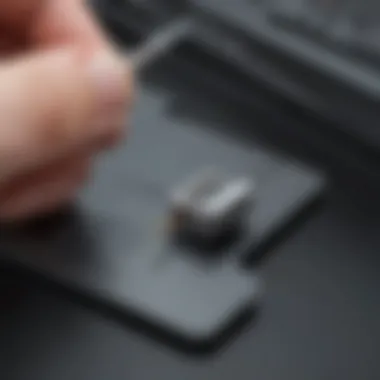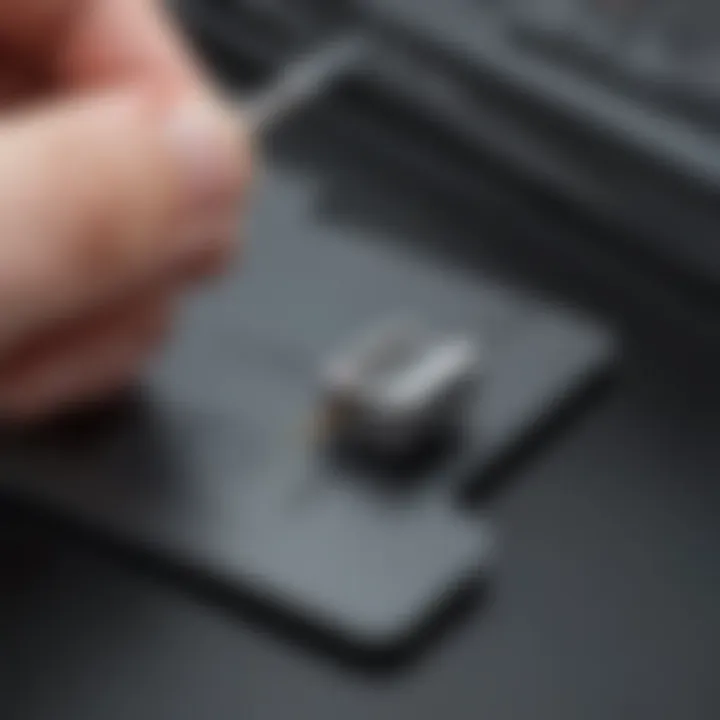Understanding the SIM Eject Pin: A Comprehensive Guide


Intro
The SIM eject pin, a seemingly simple tool, plays a vital role in the functionality of mobile devices. Though often overlooked, it enables users to access the SIM card, which is essential for connecting to networks. Understanding its design and operational mechanics can clarify the significance of this piece of technology in the context of mobile phones.
Key Points to Discuss
The comprehensive guide will explore several key elements:
- Design: The specific features of the SIM eject pin, including materials and structure.
- Operation: How the pin works within mobile devices to facilitate SIM card removal.
- Practical Applications: Practical use cases and situations where the pin is necessary.
- Troubleshooting: Common issues and solutions related to SIM card access.
- Best Practices: Recommended methods for effectively using the pin and maintaining SIM cards.
- Evolution of SIM Technology: A brief overview of how SIM cards and their removal methods have developed over time.
This guide aims to equip readers with a solid understanding of the SIM eject pin's importance in mobile technology and how it fits into the broader landscape of smartphones. By detailing design, operation, and practical use, readers will also be ready to troubleshoot and maintain their devices more effectively.
The Functionality of the SIM Eject Pin
The SIM eject pin serves a critical role in the world of mobile technology. It is often overlooked, yet understanding its functionality can enhance the user experience with smartphones and tablets. The SIM eject pin is essential for the simple task of accessing the SIM card tray. Here we explore what the SIM eject pin is, its design and construction, and how its mechanism works. Each of these elements contributes significantly to its overall importance in mobile devices.
What is a SIM Eject Pin?
A SIM eject pin is a small, pointed tool primarily used to remove the SIM card tray from mobile devices. It is usually made of metal or sturdy plastic, ensuring durability during repeated use. The pin is often included with new smartphones, alongside user manuals and charging accessories. While the main purpose is straightforward—facilitating access to the SIM card—it also plays a role in enabling users to switch between different cellular providers or upgrade their device connectivity as needed.
Design and Construction
The design of the SIM eject pin is intentionally minimalist. Its compact size usually measures a few centimeters in length, making it portable and easy to store. Many manufacturers provide the pin with a small keychain holder or a dedicated slot within the phone's packaging, ensuring it is always accessible.
The construction typically involves materials that resist bending, ensuring prolonged usability. The pointed end allows for easy insertion into the SIM card tray slot, while the opposite end may be designed for better grip. Such thoughtful design helps prevent damage to the device and the SIM card during removal or insertion.
The Mechanism
To understand the importance of the SIM eject pin, one must grasp its mechanism. The SIM card tray is designed with a spring-loaded mechanism that securely holds the card in place. When the eject pin is inserted into the designated hole, it depresses a small latch. This action releases the tray, allowing it to slide out easily. This designed efficiency means that users can quickly change their SIM cards with minimal effort and risk of damage.
In summary, the SIM eject pin is an integral tool that enhances mobility and flexibility for smartphone users. Recognizing its functionality, design elements, and mechanism demystifies its role and can lead to a smoother experience when managing SIM cards. As mobile technology continues to evolve, the importance of this small yet significant tool remains steadfast.
How to Use a SIM Eject Pin
Using a SIM eject pin is a necessary skill for mobile device owners, especially when it comes to managing SIM cards. Understanding how to effectively utilize this small tool can save time and prevent damage to your devices. The process involves specific movements and handling techniques that ensure a smooth experience when accessing mobile slots. Here, we provide essential details about the practical usage of a SIM eject pin.
Step-by-Step Removal Process
Removing a SIM card using a SIM eject pin is straightforward but requires careful attention to detail. Follow these steps for effective removal:
- Power Down Your Device: Begin by turning off your smartphone. This reduces the risk of data loss and protects the internal components.
- Identify the SIM Tray Location: Most smartphones have the SIM tray located on the side. Look for a small pinhole near the tray.
- Insert the SIM Eject Pin: Take your SIM eject pin and gently insert it into the pinhole. Ensure that you align it correctly; a misaligned insertion may lead to complications.
- Apply Gentle Pressure: Push the pin inward until the tray pops out. Avoid using excessive force as this may damage the mechanism.
- Carefully Pull Out the Tray: Once it emerges, carefully pull the tray out fully. Setting the SIM tray on a clean surface is a good practice.
- Remove the SIM Card: Finally, take the SIM card off the tray. Be careful not to touch the metal connectors to prevent any contamination.
By following these steps, you can effectively remove the SIM card without causing unnecessary harm or prolonging the process. \n
Inserting the SIM Eject Pin
Inserting the SIM eject pin is the crucial first step when trying to access your device’s SIM tray. A proper insertion method ensures you do not damage the tool or your phone. Here’s how:
- Prepare the Device: Make sure your smartphone is turned off. This prevents any risk of electrical issues.
- Locate the Pinhole: The pinhole is tiny but noticeable next to the SIM tray. It is often marked, making it easy to find.
- Align the Pin: Hold the SIM eject pin firmly but lightly. Place it perpendicular to the hole to avoid any angled pressure.
- Gentle Insertion: Slowly insert the pin into the hole. You should feel a slight resistance before it reaches the mechanism inside.
- Continue Gently: As you reach the point where you feel it engage, maintain consistent and gentle pressure until the tray pops out.
Following these insertion tips helps to ensure that the SIM tray ejects cleanly and reliably each time. Overall, mastering the use of a SIM eject pin is a valuable skill for any smartphone user.


Common Challenges
In the realm of mobile technology, particularly concerning SIM cards, challenges can arise that hinder the user experience and can lead to frustration. Addressing these common challenges is essential for anyone who routinely manages their SIM cards. Understanding these issues allows users to take proactive measures to avoid them. This section focuses on two prevalent challenges: stuck SIM cards and damaged eject pins. Each problem comes with specific causes and potential solutions that are crucial for effective handling.
Stuck SIM Cards
A frequently encountered problem is a stuck SIM card. This issue can occur due to a variety of reasons, including improper insertion, accumulated dust, or even a misaligned tray. When a SIM card becomes stuck in its slot, it can cause inconveniences, particularly for those who frequently change their SIM cards for different network providers or data plans.
- Improper Insertion: If the SIM card is incorrectly placed in the tray, it may not sit properly, making it difficult to remove.
- Dust and Debris: Over time, particles can build up around the SIM card slot. This accumulation can create friction, making it harder to eject the card.
- Misalignment: Sometimes, the card tray may not align correctly. This misalignment can lead to a situation where the card is not fully seated, complicating the removal process.
To resolve a stuck SIM card, consider these approaches:
- Gently wiggle the card: This can help dislodge it if it is not fully seated.
- Use the SIM eject pin: Apply steady pressure to the tray. If the tray does not pop out, avoid forcing it, as this may cause damage.
- Clean the area: If dust is visible, use a soft brush or compressed air to clear the slot.
Damaged Eject Pins
The second notable challenge involves damaged SIM eject pins. A pin is an essential tool designed to enter the small hole on the SIM tray, initiating the ejection mechanism. However, these pins can sustain damage due to several factors:
- Improper Handling: Bending or applying excessive force can easily damage a SIM eject pin.
- Wear and Tear: Over time and repeated use, the pin can become worn, compromising its effectiveness.
- Using Alternative Tools: Some users resort to makeshift solutions, such as using a paperclip. This can lead to inadequate ejection and potential damage.
To mitigate problems associated with damaged eject pins, users should:
- Inspect the pin regularly: Check for any signs of bending or breakage, replacing it if necessary.
- Use dedicated tools: Always use an authentic SIM eject pin or a purpose-made tool instead of improvising.
- Store the pin properly: Keeping it in a designated location can prevent loss and accidental damage.
Alternative Methods for SIM Card Removal
In some situations, using the dedicated SIM eject pin may not be achievable or convenient. Understanding alternative methods for SIM card removal is essential, especially for those who frequently change or upgrade their SIM cards. These methods provide quick solutions when the standard tool is not at hand. Moreover, knowing these alternatives can prevent damage to the device or SIM card during the removal process.
Using a Paperclip
A common household item, the paperclip can serve as an effective substitute for a SIM eject pin. To use a paperclip, follow these steps:
- Take an unbent paperclip or at least one that has a pointed end.
- Insert the pointed end into the SIM tray's eject hole with a gentle but firm pressure.
- Push until you hear a slight click or feel resistance, indicating the tray is released.
- Pull out the SIM tray carefully, ensuring you do not force it, which could lead to damage.
Using a paperclip has several benefits. It is widely available and inexpensive. Most people have one at home or can find it in their workspace. Despite this practicality, care should be taken to avoid excessive force. This method relies on patience and a gentle touch.
Other Household Items
Apart from paperclips, several other household items can help in ejecting SIM cards. Here are a few examples and their considerations:
- Safety Pins: Similar to paperclips, safety pins have a pointed end that can be inserted into the eject hole. Be cautious using this method to avoid injury.
- Toothpicks: A wooden or plastic toothpick can serve as a last-resort tool. However, it may break during use, which could complicate removal.
- Needles: If available, sewing needles are also effective. Like safety pins, care must be taken to avoid injury to oneself or damage to the device.
It's prudent to assess the item being considered for use. Ensure it is sturdy enough to handle insertion but not so sharp that it might cause harm or damage. In the absence of the SIM eject pin, these alternatives become practical solutions to execute a simple task effectively.
A critical aspect of the alternatives is the awareness of the potential risks. Always proceed with caution.
Using these methods is not just about resourcefulness; it demonstrates an understanding of practicality, especially for avid technology users who may find themselves in unexpected situations.
The Importance of SIM Card Maintenance
SIM card maintenance is a critical aspect often overlooked by smartphone users. Regular care of your SIM card can enhance device performance and prolong its lifespan. Proper maintenance ensures a seamless connection to your network provider and helps in maintaining the integrity of your data. The significance lies not just in the physical state of the card but also in the long-term usability and security of your mobile device.
Monitoring SIM Card Condition


Monitoring the condition of your SIM card is essential for detecting any issues early on. Users should regularly check for signs of wear or damage. Common indicators include:
- Physical damage: Scratches or cracks on the SIM card can affect its functionality.
- Connection issues: Unstable connectivity may suggest an underlying issue with the SIM card or its slot.
- Software updates: Sometimes, performing software updates may require you to reinsert your SIM card. This is an opportunity to check its condition.
A thorough examination can reveal potential problems, minimizing the risk of unexpected disruptions in service. Consider keeping your SIM card in a protective case when not in use. This small step can prevent physical damage from dust or accidental drops.
Cleaning Techniques
Cleaning your SIM card can contribute greatly to its performance and longevity. However, care must be taken during the cleaning process to avoid causing more harm. Here are some effective techniques for cleaning your SIM card:
- Microfiber cloth: Use a clean microfiber cloth to gently wipe the surface of the SIM card. This helps to remove any dirt or smudges that may interfere with connectivity.
- Isopropyl alcohol application: A diluted solution of isopropyl alcohol can be used to clean stubborn stains. Apply the alcohol to the cloth, not directly onto the SIM card. Avoid using any other cleaning agents, as they may damage the card.
- Gentle scrubbing: If there is visible debris or foreign materials, use a soft-bristled toothbrush to carefully remove them. Ensure that the SIM slot and the card are completely dry before reinserting it back.
Proper maintenance, including cleaning and monitoring, can extend the life of a SIM card significantly.
Maintaining your SIM card ensures that you maximize its effectiveness, leading to improved network performance and service reliability. For more insights on mobile technology, visit Wikipedia, or engage with discussions on forums like Reddit.
The Evolution of SIM Technology
The evolution of SIM technology is a critical aspect of mobile communications. As mobile devices advanced, so too did the technology that enables them to connect to networks. This evolution has not just altered how users interact with mobile technology but has also improved security, efficiency, and functionality in communication.
From Mini-SIM to Nano-SIM
Initially, the Standard SIM card was the widely accepted format for mobile devices. With time, as the need for smaller devices grew, the Mini-SIM was introduced. This card was more compact while still supporting similar functionalities. However, as smartphones became thinner and lighter, the Mini-SIM was soon replaced by the Nano-SIM.
The Nano-SIM is about 40% smaller than its predecessor. This reduced size allows smartphone manufacturers to utilize the extra space for improved batteries or other technology such as better cameras and processors. The transition from Mini-SIM to Nano-SIM showcases how SIM technology has adapted to meet the demands of the consumer electronics industry. Each change aims to enhance user experience without compromising the fundamental capabilities of the SIM.
Embedded SIM (eSIM) Technology
The development of Embedded SIM, commonly referred to as eSIM, marks a significant leap in SIM technology. Unlike traditional SIM cards that need physical insertion or removal, eSIM is embedded directly into the device's motherboard. This eliminates the need for a SIM card tray or eject pin, providing several advantages.
- Space Efficiency: With eSIM, manufacturers can design slimmer devices, making efficient use of internal space.
- Remote Provisioning: Users can switch carriers and plans without physically changing a SIM card. This enhances convenience and flexibility, especially for frequent travelers.
- Enhanced Durability: eSIMs are more secure as they are less susceptible to damage from elements like water or dust compared to standard SIM cards.
The shift to eSIM technology represents a fundamental change in how mobile devices manage network identities, thereby reshaping the future of connectivity.
Importance in Mobile Technology
The role of the SIM eject pin extends beyond a simple tool for removing SIM cards; it is integral to the functioning of mobile technology. This small, often overlooked device plays a critical part in connecting users to their mobile networks. By facilitating the removal and insertion of SIM cards, the SIM eject pin enables users to maintain connectivity while managing their mobile subscriptions seamlessly.
Role in Network Connectivity
When users wish to switch networks or modify their mobile services, the SIM eject pin allows for easy access to the SIM slot within the device. Mobile phones depend on SIM cards to authenticate and connect to cellular networks.
- Network Switching: The SIM eject pin allows users to change their SIM cards quickly. This flexibility is essential for those traveling internationally or for users who wish to capitalize on better network deals.
- Service Upgrades: Users can easily upgrade their services by swapping in a new SIM card, including the latest 5G compatible cards that enhance data speeds and connectivity.
- Multiple Profiles: Many smartphones now allow users to have dual SIM capabilities. With a SIM eject pin, managing multiple carriers or plans becomes straightforward, improving user options without technical barriers.
The ease of switching SIM cards affects not just individual users but also influences overall network efficiency and customer satisfaction.
Data Security Considerations
Maintaining data security is another crucial aspect tied to the use of the SIM eject pin. Users must be aware of the potential risks associated with SIM card handling and management.
- Unauthorized Access: Removing a SIM card is often necessary in the event of a lost or stolen phone. Secure handling ensures that sensitive personal data is not easily accessed by unauthorized individuals.
- Carrier Locking: When inserting or removing a SIM card, users must be vigilant about ensuring that their devices are not physically damaged. Any faults can lead to potential breaches of security protocols, particularly if the SIM is in an insecure device.
- Data Encryption: Mobile service providers increasingly incorporate data encryption on SIM cards. When replacing or switching cards, understanding these protocols becomes essential for safeguarding personal data.


The significance of the SIM eject pin reflects its dual role in enhancing connectivity while necessitating careful attention to data security practices. The intersection of these aspects marks a pivotal point in the mobile technology landscape that impacts user experience and device functionality.
Best Practices for Using a SIM Eject Pin
Using a SIM eject pin requires care and attention to detail to ensure both effectiveness and safety. Given the prominence of mobile devices in our daily lives, mastering the best practices in handling a SIM eject pin is essential. It not only prevents damage to the device but also guarantees a smooth experience while managing SIM cards. This section will detail proper handling techniques and provide useful storage recommendations, making it easier for users to integrate these practices into their routine.
Proper Handling Techniques
Handling a SIM eject pin might appear straightforward, but there are crucial techniques that must be observed to prevent mishaps. Here are the primary recommendations:
- Grip Firmly, But Gently: Hold the SIM eject pin firmly but avoid excessive force, as it can cause bending or damage to the pin.
- Angled Insertion: Always insert the pin at a slight angle towards the SIM tray hole. This strategy minimizes the risk of forcing it into the device.
- Avoid Using Metal Objects: It may be tempting to use metal objects like screws or needles, but this can easily cause internal damage. Stick to the proper pin specifically designed for the purpose.
- Check for Obstructions: Before inserting the pin, make sure the area around the SIM tray is clear from dust or debris, which can obstruct the process.
Following these techniques not only protects the physical integrity of the devices but also enhances the user’s overall experience when accessing the SIM card.
Storage Recommendations
Storing a SIM eject pin might seem like a trivial task, but how and where it is kept can significantly influence its usability and lifespan.
- Designated Compartment: Keep the pin in a specific compartment of your bag or drawer. This helps ensure you can find it with ease when needed.
- Protective Cases: Consider using small protective cases to prevent the pin from bending or getting lost. This is especially important if you travel frequently.
- Label Containers: If you have multiple tools or devices, label your containers. This practice will make it easier to locate your SIM eject pin amid other items.
- Handling Moisture: Avoid storing the pin in damp areas, as moisture could lead to rust or degradation of the pin material over time.
By adhering to these storage recommendations, users can maintain the functionality of their SIM eject pins and ensure they are readily available when necessary.
Troubleshooting Common Issues
Troubleshooting common issues related to the SIM eject pin is crucial for ensuring mobile device functionality. Many users encounter problems when handling their SIM cards and the corresponding eject pin.
Understanding these challenges helps to enhance user experience. Ignoring these issues may cause data loss or damage to the mobile device. This section outlines how to identify and resolve these common issues effectively.
Identifying Problems
When dealing with a SIM eject pin, knowing the problems that can arise is essential. Users may need to identify issues such as:
- The SIM card is stuck and cannot be removed.
- The eject pin is bent or broken.
- The SIM card tray does not fit properly.
- The device does not recognize the inserted SIM card.
Stuck SIM cards may happen due to debris or wear over time. If the SIM card has not been removed for a long period, it can stick in the tray. Moreover, a damaged eject pin can make extraction difficult, causing frustration. Understanding these signs is the first step in ensuring smooth operation.
Steps to Resolve
Resolving issues with SIM eject pins and trays requires careful handling. Here are steps to take when facing challenges:
- Examine the SIM Card Tray: Check for any visible dirt or foreign objects that may be obstructing the tray. Carefully clean the area around the tray.
- Use the Eject Pin Properly: If the eject pin bends, try to re-straighten it or replace it if necessary. Ensure that you insert the pin into the designated hole firmly but gently.
- Apply Minimal Pressure: If the SIM card is stuck, avoid using excessive force. Gently wiggle the tray while pulling it out.
- Refer to Manufacturer Specifications: Different mobile devices have specific instructions for SIM removal. Always refer to the user manual for precise guidance.
- Seek Professional Help: If all else fails, it might be wise to consult a technician. They can assist with complex issues, ensuring that your device remains intact.
"Regular maintenance of your SIM card and eject pin can reduce the likelihood of encountering issues. Keep the area around the SIM card tray clean and check for damages periodically."
By following these steps, users can manage common problems associated with the SIM eject pin, ensuring a more seamless mobile experience.
Finale
In concluding this article, it is essential to reflect on the significance of the SIM eject pin in modern mobile technology. Understanding its function and maintenance can enhance user experience and device longevity. The SIM eject pin is not merely a simple tool; it serves as a gateway to managing mobile connectivity. Its proper use allows users to replace or upgrade SIM cards seamlessly, adapting to their changing needs in a fast-evolving technological landscape.
Recap of Key Points
- Definition and Purpose: The SIM eject pin's primary role is to eject SIM cards from devices, facilitating easy access for users.
- Design and Mechanism: Its straightforward design includes a pointed tip for precision, ensuring that users can operate it with minimal effort.
- Common Challenges: Users may encounter stuck SIM cards or damaged eject pins, highlighting the importance of troubleshooting techniques discussed earlier.
- Alternative Methods: In cases where the eject pin is unavailable, various household items can serve as effective substitutes, ensuring continued access to SIM slots.
- Maintenance: Regular monitoring and cleaning of the SIM card can prevent common issues and extend its life.
- Future Technology: With the rise of eSIM technology, understanding traditional SIM cards and eject pins will remain relevant as mobile technology evolves.
Future Perspectives
The landscape of mobile technology is constantly changing. As innovations, like embedded SIM technology, gain traction, the relevance of physical SIM eject pins may diminish. However, even with advancements, understanding the existing systems remains crucial. Future devices may incorporate integrated eSIMs, yet knowledge of traditional SIM management techniques through pins will provide a foundational understanding for users. Moreover, as data security becomes even more critical, the importance of maintaining SIM integrity will ensure that users remain vigilant regarding their devices.
Ultimately, the SIM eject pin is a small yet vital component in the overall functioning of smartphones. Mastery over its use empowers users to take full control of their mobile devices, reinforcing the necessity of this often-overlooked tool.



